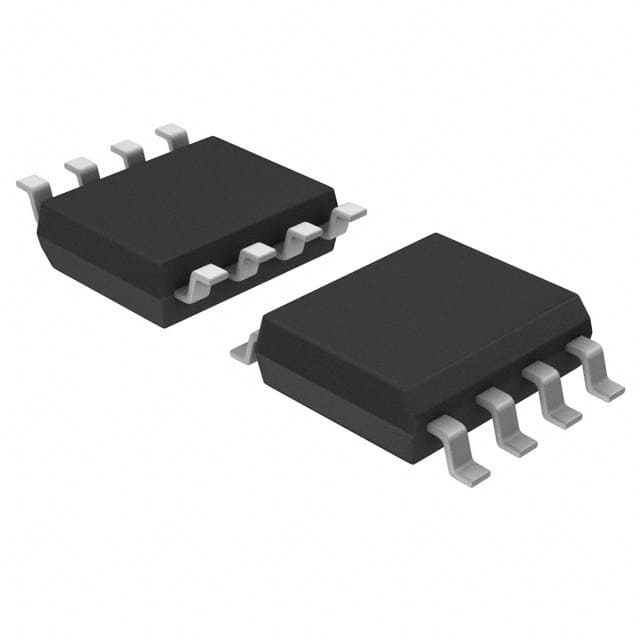Consulte las especificaciones para obtener detalles del producto.

TL431BCDR2
Product Overview
- Category: Integrated Circuit (IC)
- Use: Voltage Reference
- Characteristics: Adjustable, Precision, Shunt Regulator
- Package: SOIC-8
- Essence: TL431BCDR2 is a three-terminal adjustable precision shunt regulator. It can be used to provide a stable reference voltage in various electronic circuits.
- Packaging/Quantity: TL431BCDR2 is typically sold in reels of 2500 units.
Specifications
- Reference Voltage Range: 2.495V to 36V
- Operating Current Range: 1mA to 100mA
- Temperature Range: -40°C to +85°C
- Line Regulation: 0.2% (Typical)
- Load Regulation: 0.4% (Typical)
- Output Voltage Tolerance: ±1%
- Cathode Current: 1mA to 100mA
Detailed Pin Configuration
TL431BCDR2 has eight pins arranged as follows:
```
| | --| REF K |-- Cathode --| ADJ A |-- Anode --| GND N |-- Ground |___________| ```
Functional Features
- Adjustable Output Voltage: The output voltage of TL431BCDR2 can be easily adjusted using external resistors.
- Precision Voltage Reference: TL431BCDR2 provides a highly accurate and stable reference voltage for precise circuit operation.
- Shunt Regulator: It acts as a shunt regulator by maintaining a constant voltage drop across the device terminals.
- Low Power Consumption: TL431BCDR2 consumes very low power, making it suitable for battery-powered applications.
- Wide Operating Temperature Range: It can operate reliably in a wide temperature range, making it suitable for various environments.
Advantages and Disadvantages
Advantages: - High precision and stability - Adjustable output voltage - Low power consumption - Wide operating temperature range
Disadvantages: - Requires external resistors for voltage adjustment - Limited maximum cathode current
Working Principles
TL431BCDR2 works based on the principle of a shunt regulator. It compares the reference voltage at the REF pin with the voltage across the ADJ and K pins. By adjusting the voltage at the ADJ pin, the output voltage can be set to a desired value. The TL431BCDR2 maintains a constant voltage drop between the ADJ and K pins, ensuring a stable output voltage.
Detailed Application Field Plans
TL431BCDR2 finds applications in various electronic circuits where a stable reference voltage is required. Some common application areas include:
- Voltage regulators
- Switching power supplies
- Battery chargers
- Audio amplifiers
- LED drivers
- Industrial control systems
Detailed and Complete Alternative Models
Some alternative models that can be used as substitutes for TL431BCDR2 are:
- TL431ACDR2: Similar specifications and pin configuration, but with tighter voltage tolerance.
- LM4040CIZ-4.1: Fixed 4.1V voltage reference with similar package and pin configuration.
- LT1009CZ-2.5: Fixed 2.5V voltage reference with similar characteristics and package.
These alternative models provide similar functionality and can be used depending on specific requirements.
Word count: 446 words
Enumere 10 preguntas y respuestas comunes relacionadas con la aplicación de TL431BCDR2 en soluciones técnicas
Sure! Here are 10 common questions and answers related to the application of TL431BCDR2:
Q: What is TL431BCDR2? A: TL431BCDR2 is a programmable precision voltage reference integrated circuit (IC) commonly used in technical solutions.
Q: What is the purpose of TL431BCDR2? A: TL431BCDR2 is primarily used as a voltage reference or shunt regulator in various applications, such as power supplies, battery chargers, and voltage monitoring circuits.
Q: How does TL431BCDR2 work? A: TL431BCDR2 compares the input voltage with an internal reference voltage and adjusts its output accordingly to maintain a stable voltage level.
Q: What is the voltage range of TL431BCDR2? A: The voltage range of TL431BCDR2 is typically between 2.5V and 36V.
Q: Can TL431BCDR2 be used as a current regulator? A: Yes, TL431BCDR2 can be used as a current regulator by connecting it in series with a resistor and adjusting the resistor value to control the desired current.
Q: Is TL431BCDR2 suitable for high-frequency applications? A: TL431BCDR2 is not specifically designed for high-frequency applications, but it can still be used in moderate frequency circuits.
Q: What is the maximum current TL431BCDR2 can handle? A: TL431BCDR2 can handle a maximum cathode current of 100mA.
Q: Can TL431BCDR2 operate in both positive and negative voltage supplies? A: Yes, TL431BCDR2 can operate in both positive and negative voltage supplies, making it versatile for various applications.
Q: Does TL431BCDR2 require external components for operation? A: Yes, TL431BCDR2 requires external resistors and capacitors to set the desired voltage reference and stability.
Q: Are there any alternative devices to TL431BCDR2? A: Yes, some alternative devices to TL431BCDR2 include LM431, TLVH431, and LT1634, which offer similar functionality with slight variations in specifications.
Please note that these answers are general and may vary depending on specific application requirements.

